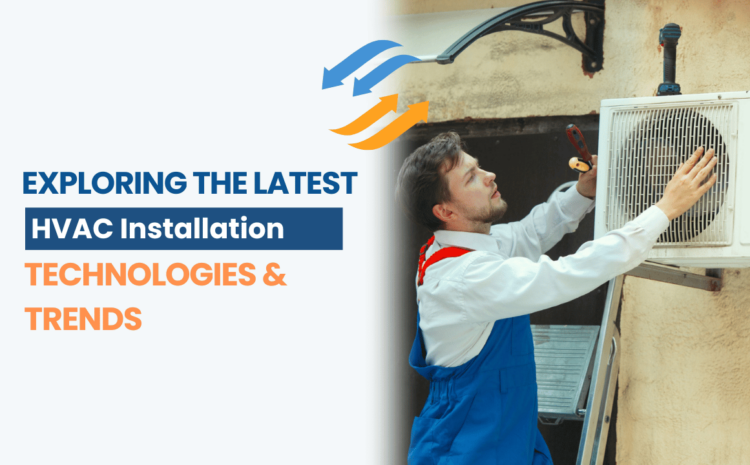
The HVAC (Heating, Ventilation, and Air Conditioning) industry is constantly evolving, driven by advances in technology and increasing demands for energy efficiency and sustainability. As homeowners and businesses look to modernize their systems, staying informed about the latest HVAC installation technologies and trends can help you make informed decisions that improve comfort, reduce energy costs, and contribute to a greener planet. In this blog, we’ll explore some of the most exciting developments in the HVAC world.
1. Smart Thermostats and Controls
Smart thermostats are revolutionizing the way we interact with our HVAC systems. These devices allow for remote control via smartphone apps, enabling users to adjust temperatures, set schedules, and monitor energy usage from anywhere. Some smart thermostats even learn your preferences over time, optimizing heating and cooling cycles to enhance comfort and efficiency automatically.
Key Benefits:
Energy savings through optimized heating and cooling.
Increased convenience and control.
Enhanced comfort with personalized settings.
2. Variable Refrigerant Flow (VRF) Systems
Variable Refrigerant Flow (VRF) systems are gaining popularity, especially in commercial buildings. These systems use refrigerant as the heating and cooling medium and can simultaneously heat and cool different zones in a building. VRF systems are known for their energy efficiency, flexibility, and precise temperature control.
Key Benefits:
Energy-efficient operation.
Zoned comfort with individual controls.
Reduced energy consumption compared to traditional systems.
3. Ductless Mini-Split Systems
Ductless mini-split systems are an excellent solution for homes without existing ductwork. These systems consist of an outdoor compressor unit and one or more indoor air-handling units, providing targeted heating and cooling without the need for ducts. They are ideal for additions, renovations, and areas with specific temperature control needs.
Key Benefits:
Easy installation with no ductwork required.
Energy-efficient and customizable comfort.
Quiet operation and improved air quality.
4. Geothermal Heat Pumps
Geothermal heat pumps leverage the stable temperatures underground to provide heating and cooling. These systems are highly efficient and environmentally friendly, offering significant energy savings and reduced greenhouse gas emissions. While the initial installation cost can be high, the long-term savings and sustainability make geothermal systems an attractive option.
Key Benefits:
High energy efficiency and lower operating costs.
Environmentally friendly with reduced carbon footprint.
Long lifespan and reliable performance.
5. Energy Recovery Ventilators (ERVs) and Heat Recovery Ventilators (HRVs)
ERVs and HRVs improve indoor air quality and energy efficiency by exchanging stale indoor air with fresh outdoor air while transferring heat between the incoming and outgoing air streams. This process reduces the load on the HVAC system and maintains a comfortable and healthy indoor environment.
Key Benefits:
Improved indoor air quality.
Enhanced energy efficiency by recovering heat.
Balanced ventilation and humidity control.
6. Solar-Powered HVAC Systems
As renewable energy becomes more accessible, solar-powered HVAC systems are emerging as a sustainable solution. These systems use solar panels to generate electricity, reducing reliance on the grid and lowering energy bills. Integrating solar power with HVAC systems can significantly reduce a building’s carbon footprint.
Key Benefits:
Reduced energy bills through solar power.
Environmentally friendly and sustainable.
Potential for energy independence.
7. Advanced Air Filtration and Purification
With increasing concerns about indoor air quality, advanced air filtration and purification systems are becoming essential components of modern HVAC installations. Technologies like HEPA filters, UV-C light, and electrostatic filters can effectively remove pollutants, allergens, and pathogens from the air, promoting healthier indoor environments.
Key Benefits:
Improved indoor air quality.
Removal of allergens, pollutants, and pathogens.
Enhanced comfort and health for occupants.
8. IoT Integration and Predictive Maintenance
The Internet of Things (IoT) is transforming HVAC maintenance and management. IoT-enabled HVAC systems can monitor performance, detect issues early, and schedule maintenance automatically. Predictive maintenance reduces downtime, extends equipment life, and ensures optimal system performance.
Key Benefits:
Reduced maintenance costs and downtime.
Proactive issue detection and resolution.
Enhanced system reliability and performance.
Conclusion
The latest HVAC installation technologies and trends are driving significant improvements in energy efficiency, comfort, and sustainability. By staying informed about these advancements, homeowners and businesses can make smarter choices that not only enhance their living and working environments but also contribute to a greener future. Whether you’re considering a new HVAC installation or upgrading your existing system, exploring these innovative solutions can lead to better performance and long-term savings.


